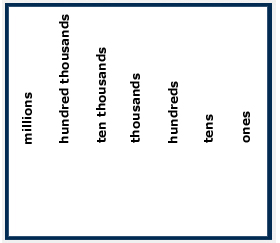place value
In our decimal number system, the value of a digit depends on its place, or position, in the number. Each place has a value of 10 times the place to its right.
A number in standard form is separated into groups of three digits using commas. Each of these groups is called a period.

The idea of place value is at the heart of our number system. First, however, a symbol for nothing--our zero--had to be invented. Zero "holds the place" for a particular value, when no other digit goes in that position. For example, the number "100" in words means one hundred, no tens, and no ones. Without a symbol for nothing, our decimal number system wouldn't work.
Beginning with the ones place at the right, each place value is multiplied by increasing powers of 10. For example, the value of the first place on the right is "one", the value of the place to the left of it is "ten," which is 10 times 1. The place to the left of the tens place is hundreds, which is 10 times 10, and so forth.
For easier readability, commas are used to separate each group of three digits, which is called a period. When a number is written in this form, it is said to be in "standard form."

Examples
Numbers can be represented in many ways, but standard form is usually the easiest and shortest way. Here are some numbers expressed in different forms, with their standard form shown alongside. Which form do you think is the best?
Example 1
one billion, sixty million, five hundred twenty thousand
1,060,520,000
Example 2
four hundred sixteen thousand, seven hundred thirty-one
416,731
Example 3
6,000,000 + 70,000 + 20 + 1
6,070,021
Try It!
In each of these numbers, what value does the digit 5 have?
In 17,526,010 the 5 represents " five hundred thousands"
In 2,110,735,000 the 5 represents "five thousands"
In 2,110,735,000 the 5 represents "five thousands"
Hiç yorum yok:
Yorum Gönder